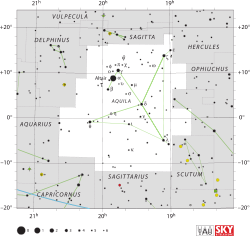Psi Aquilae

| |
| Observation data Epoch J2000 Equinox J2000 | |
|---|---|
| Constellation | Aquila |
| Right ascension | 19h 44m 34.19197s[1] |
| Declination | +13° 18′ 10.0203″[1] |
| Apparent magnitude (V) | 6.25[2] |
| Characteristics | |
| Spectral type | B9 III-IV[3] |
| U−B color index | –0.22[4] |
| B−V color index | –0.04[4] |
| Astrometry | |
| Radial velocity (Rv) | –18.3[5] km/s |
| Proper motion (μ) | RA: +2.17[1] mas/yr Dec.: –10.56[1] mas/yr |
| Parallax (π) | 3.22 ± 0.41 mas |
| Distance | approx. 1,000 ly (approx. 310 pc) |
| Details | |
| Radius | 3.7[6] R☉ |
| Temperature | 10,814 ± 232[7] K |
| Rotational velocity (v sin i) | 20[8] km/s |
| Other designations | |
Psi Aquilae (ψ Aql, ψ Aquilae) is the Bayer designation for a star in the equatorial constellation of Aquila. It is a faint star with an apparent visual magnitude of 6.25,[2] which, according to the Bortle Dark-Sky Scale, can be seen with the naked eye in dark rural skies. The orbit of the Earth causes an annual parallax shift of 3.22 mas,[1] which indicates a distance of roughly 1,000 light-years (310 parsecs).
The spectrum of Psi Aquilae matches a stellar classification of B9 III-IV,[3] with the luminosity class of III-IV indicating the spectrum lies part way between that of a subgiant and a giant star. The effective temperature of the star's outer atmosphere is 10,814 K,[7] giving it the blue-white hue of a B-type star.[9] It has nearly four[6] times the radius of the Sun and has a projected rotational velocity of 20 km/s.[8]
References
- 1 2 3 4 5 van Leeuwen, F. (November 2007), "Validation of the new Hipparcos reduction", Astronomy and Astrophysics, 474 (2): 653–664, arXiv:0708.1752
 , Bibcode:2007A&A...474..653V, doi:10.1051/0004-6361:20078357.
, Bibcode:2007A&A...474..653V, doi:10.1051/0004-6361:20078357. - 1 2 3 "psi Aql -- Star", SIMBAD, Centre de Données astronomiques de Strasbourg, retrieved 2012-07-21.
- 1 2 Cowley, A. (November 1972), "Spectral classification of the bright B8 stars", Astronomical Journal, 77: 750–755, Bibcode:1972AJ.....77..750C, doi:10.1086/111348.
- 1 2 Crawford, D. L. (February 1963), "U, b, v, and Hβ Photometry for the Bright B8- and B9-TYPE Stars", Astrophysical Journal, 137: 530, Bibcode:1963ApJ...137..530C, doi:10.1086/147526.
- ↑ Evans, D. S. (June 20–24, 1966), Batten, Alan Henry; Heard, John Frederick, eds., The Revision of the General Catalogue of Radial Velocities, University of Toronto: International Astronomical Union, Bibcode:1967IAUS...30...57E.
- 1 2 Pasinetti Fracassini, L. E.; et al. (February 2001), "Catalogue of Apparent Diameters and Absolute Radii of Stars (CADARS) - Third edition - Comments and statistics", Astronomy and Astrophysics, 367: 521–524, arXiv:astro-ph/0012289
 , Bibcode:2001A&A...367..521P, doi:10.1051/0004-6361:20000451.
, Bibcode:2001A&A...367..521P, doi:10.1051/0004-6361:20000451. - 1 2 Paunzen, E.; Schnell, A.; Maitzen, H. M. (December 2005), "An empirical temperature calibration for the Δa photometric system. I. The B-type stars", Astronomy and Astrophysics, 444 (3): 941–946, arXiv:astro-ph/0509049
 , Bibcode:2005A&A...444..941P, doi:10.1051/0004-6361:20053546.
, Bibcode:2005A&A...444..941P, doi:10.1051/0004-6361:20053546. - 1 2 Abt, Helmut A.; Levato, Hugo; Grosso, Monica (July 2002), "Rotational Velocities of B Stars", The Astrophysical Journal, 573 (1): 359–365, Bibcode:2002ApJ...573..359A, doi:10.1086/340590.
- ↑ "The Colour of Stars", Australia Telescope, Outreach and Education, Commonwealth Scientific and Industrial Research Organisation, December 21, 2004, retrieved 2012-01-16